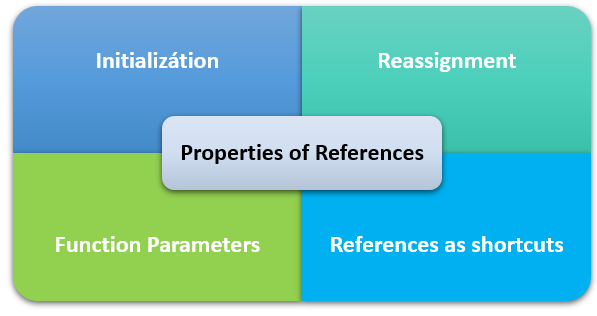


本教程将通过简单的示例介绍 C++ 中的引用主题。
当变量被声明为引用时,它将通过指向现有内存而非生成新内存,成为现有变量的别名。这些变量也称为别名变量或链接变量。指针的问题在于我们将来可以更改现有变量的地址,这会使其不安全。为了解决这个问题,使用了引用变量。
众所周知,C++ 主要支持两种类型的变量
普通变量是一种主要保存某种类型值的变量。例如,假设我们构造或创建了一个 int 类型的变量,这意味着该变量将能够保存整数类型的值。
包含另一个变量地址的变量称为指针。该指针指向的值可以通过解引用来检索。
引用是 C++ 支持的一种不同类型的变量。作为另一个变量的别名的变量称为引用。
可以使用与号(&)运算符来创建引用。假设我们正在创建一个变量,它占用一些内存空间。我们有能力为该变量创建一个引用;因此,我们可以使用变量名或引用来检索原始变量。
语法
data_type &refernce_variabe=value_variable;
例如
int a=7;
int &z=a;//now here you can see both z and a have the same address
前面示例中的变量“a”和“z”指向相同的内存地址。因此,“z”现在已成为“a”的别名。对“a”的任何修改也会影响“z”,反之亦然。
例如:让我们编写一个 C++ 程序,它将使用 int 和 double 的引用。
#include <iostream>
using namespace std;
int main () {
// declare the simple variables
int i;
double d;
// declare the reference variables
int& r = i;
double& s = d;
i = 7;
cout << " The value of i : " << i << endl;
cout << "The value of i reference : " << r << endl;
d = 11.7;
cout << "The Value of d will be : " << d << endl;
cout << "The Value of d reference will be : " << s << endl;
return 0;
}
输出
The value of i : 7 The value of i reference : 7 The Value of d will be : 11.7 The Value of d reference will be : 11.7
使用引用类型变量和 & 运算符可以声明它。
#include <iostream>
using namespace std;
int main()
{
int a=100;
int &value=a;
std::cout << value << std::endl;
return 0;
}
输出
100
被引用的变量的另一个名称是引用作为别名。
例如,
int a=50; // 'a' is a variable.
int &b=a; // 'b' will reference to a.
int &c=a; // 'c' will reference to a.
现在让我们编写一个简单的 C++ 程序来使其更清晰
#include <iostream>
using namespace std;
int main()
{
int a=100; // initialization of the variable
int &b=a;
int &c=a;
std::cout << " The value of a is :" <<a<< std::endl;
std::cout << " The Value of b is :" <<b<< std::endl;
std::cout << "The Value of c is :" <<c<< std::endl;
return 0;
}
输出
The value of a is :100 The Value of b is :100 The Value of c is :100
在上面的代码中,创建了一个名为“a”的变量,其值为“100”。我们的两个引用变量 b 和 c 都引用相同的变量“a”并已声明。因此,我们可以说变量“b”和“c”可以访问变量“a”。

在声明时,它必须被初始化
#include <iostream>
using namespace std;
int main()
{
int a=50; // initialization of the variable
int &b=a; // b will reference to a
std::cout << "Then the value of a is " <<b<< std::endl;
return 0;
}输出
Then the value of a is 50
在上面的代码中,我们创建了一个引用变量,即“b”。在声明时,'a'变量被赋值给'b'。如果我们在声明时没有赋值,那么代码将如下所示
int &b;
&b=a;
由于在声明时未赋值 'a',上面的代码将在编译时失败。
这表示引用变量不能更改/修改,因为它不能被重新赋值。
#include <iostream>
using namespace std;
int main()
{
int x=100; // initialization of variable
int z=7oo;
int &y=x; // y reference to x
int &y=z; // y reference to z, but it will surely throws a compile-time error.
return 0;
}
输出
Compilation error occurs
在上面的代码中,引用变量“y”用于引用变量“x”,然后将“z”赋值给“y”。由于引用变量无法进行此重新赋值,因此会生成编译时错误。
也可以将引用作为函数参数传递。它充当参数的别名,但不会复制参数。由于它不复制参数,因此提高了性能。
例如
#include <iostream>
using namespace std;
int main()
{
int a=90; // initialization of variable
int b=100; // initialization of variable
swap(a, b); // function calling
std::cout << " The value of a is :" <<a<< std::endl;
std::cout << "The value of b is :" <<b<< std::endl;
return 0;
}
void swap(int &p, int &q) // function definition
{
int temp; // declaration of the variable
temp=p;
p=q;
q=temp;
}
输出
The value of a is :100 The value of b is :90
我们正在切换上面代码中“a”和“b”的值。swap() 函数已将变量“a”和“b”作为输入接收。在 swap() 函数中,“p”代表“a”,“q”代表“b”。当我们切换“p”和“q”的值时,这同样会切换“a”和“b”的值。
引用使我们能够轻松访问嵌套数据。
#include <iostream>
using namespace std;
struct profile
{
int id;
};
struct Student
{
profile p;
};
int main()
{
Student e;
int &ref=e.p.id;
ref=27;
std::cout << e.p.id << std::endl;
}
输出
27
在前面的代码中,我们正在尝试获取学生个人资料结构体的“id”。通常,我们使用语句 e.p.id 来访问此成员,但如果我们需要多次访问,这将是一项非常困难的任务。为了防止这种情况,我们建立了一个名为 ref 的引用变量,它是“e.p.id”的另一个名称。